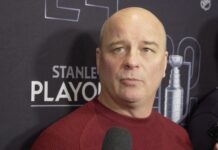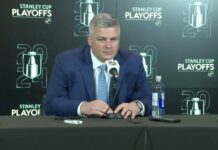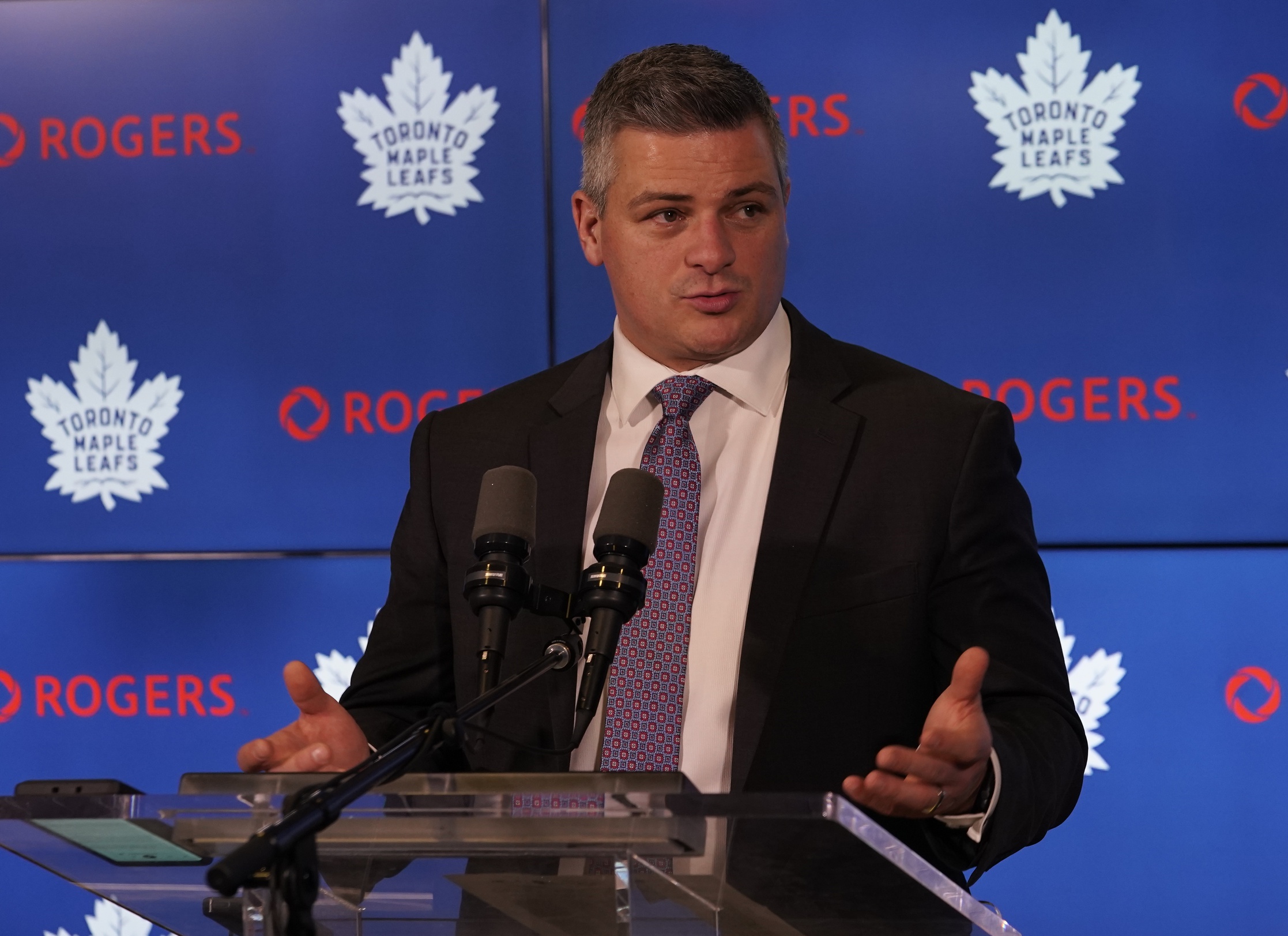Head coach Sheldon Keefe addressed the media at the opening of 2021 training camp, discussing his line combinations to start camp, the challenges of a 56-game schedule with no preseason played entirely against the same six Canadian opponents, and the team’s desire to evolve in its competitiveness, maturity, and physicality.
Toronto Maple Leafs Line Combinations for 2021 Training Camp
To conclude the press conference, Sheldon Keefe indicated he’s starting with the following forward lines in camp, noting he likes “the depth it gives the team throughout the lineup.”
Thornton – Matthews – Marner
Vesey – Tavares – Nylander
Mikheyev – Kerfoot – Hyman
Barabanov – Spezza – Simmonds
It sounds as though the coaching staff will look to keep the above NHL lines mostly together in one of two groups once the training camp roster is split for the beginning of on-ice sessions tomorrow.
The line combinations include, among the biggest surprises, Joe Thornton up on the top line left wing to serve as a veteran playmaker next to Auston Matthews and Mitch Marner, and offseason signing Jimmy Vesey receiving (to start camp, at least) a great opportunity on a line next to John Tavares and William Nylander. The team’s penciled-in third line — Mikheyev, Kerfoot, and Hyman — is a combination Keefe indicated he has been sitting on for a while, ostensibly as a potential checking trio who might be able to take on a share of the defensive assignments.
It remains to be seen if this is the lineup that emerges from camp and into the early regular season, of course; Nick Robertson, Pierre Engvall, Joey Anderson, and Travis Boyd will be pushing for minutes, and we’ll have to see how Keefe will balance managing the minutes of a 41-year-old vet like Thornton, among the many other question marks to sort out in an abbreviated evaluation period.
Sheldon Keefe’s Opening Statement
I am very excited about the players that we have added and the group that we have assembled here. The changes to the coaching staff, and the additions that we have made there, have me looking at things with lots of positivity and optimism. At the same time, the experience we had in the qualification round and the loss that we suffered there, we still feel that.
That is perhaps what excites me the most: The opportunity to continue to grow with the people that we have added and the renewed focus of the returning players that we have as well. That is a source of great excitement here. We are ready to go.
The foundation for our season is going to be set here in training camp. It is a fresh start for me. It is my first real opportunity here with what feels like a team that I helped build and be a part of the process — having an opportunity to speak with players, chat with them, and get them in the right frame of mind coming into a camp like this. Our focus is going to be on building habits and setting standards that are going to be necessary for us to have success. That starts in training camp in day one.
The specific focus for us is going to be on competitiveness, physicality, and structure. Those are going to be the three key areas for us. How I really simply define that: Our ability to make it difficult to get to our net, get in people’s way, make it a tough pathway to get access to our zone and to our net, and then to fight for space to get good ice and clear access to the opponent’s net. It’s as simple as that for me. That is where the competitiveness comes in.
In terms of the consistency, that is a whole other area for us. That standard is going to be set with our habits from day one of training camp. We will be ready to go with that starting tomorrow morning.
The camp itself is going to be really focused on practices and practice habits in in-game situations. We are going to build the habits out in that format. We will have two scrimmages throughout camp — one that is going to be over in SBA in a full game-like setting. We are going to get started right from day one. We will have two very distinct groups established right from day one tomorrow and we will get to work from there.
Sheldon Keefe Q&A
How much do you expect players like Auston Matthews and Mitch Marner to set those standards you’re talking about and pull the team along given where they are in their careers now and what they make on an annual basis?
Keefe: I think it goes without saying that you want your best people to be the ones that set the standards. It makes life a lot easier for everything to fall in place from there. We’ve had those conversations with all of our players, but particularly our top guys, regardless of age. Our top players have shown the ability to do that. We need that to be the case, certainly, but just in the additions we have made and the way the team has evolved in the offseason, we expect that level of accountability and standard to be set all the way throughout.
Do you get the sense the team has learned along the way, having been with them for a year now?
Keefe: Experience is gained through every season — the ups and downs of the season, and then, of course, the disappointing outcomes in the playoff settings. Those are the things that make you look inward and really reflect. It doesn’t just fall on individuals, of course. As an organization, we’ve got responsibilities to put the team in the best position possible for success.
We like the additions we have been able to make there. All the players, whether incoming or returning — we are excited about that. Our best players know what their responsibilities are and we feel good about where they are at to be able to deliver on that. At the same time, we need to build a team here that has great depth, which we believe we have done. Everybody has to do their part for us to have the success we want.
The uniqueness of the short training camp, and also for an NHL coaching staff to only have to focus on six other teams the entire regular season — how much onus is that going to put in you and your staff to make adjustments? You have the same team sometimes two or three nights in a row. Will that be a really important factor for your team to be able to adjust to what you see in your opponents?
Keefe: Without question, that is a factor. It is something I have a bit of experience with being in the American league, where you often do play the same team multiple times — usually not as often as three, although it is not something that never happens. Certainly, back-to-backs are quite common — it seemed to be more common than just the one-offs in the American league. I have that experience with those adjustments. You play teams up to 10 or 12 times a season in the AHL.
That is a factor. You are focusing more on your games head-to-head against the opponent rather than looking at the teams playing against others. I am excited about that. I think it allows you to zero in on a small number of opponents and get to know them very well. Probably most importantly, what it does is free up so much time to focus on your own team. That is really where we are at: making sure our game is right.
With the rivalries and playing the teams so many times, how nasty do you think it could all get?
Keefe: I think there is always the potential for that. I don’t know if the American league is the right comparison necessarily because it seems to have the opposite effect. You tend to get sick of it and you just kind of get through it. I don’t see that happening in the NHL with so much at stake and the rivalries built-in within the uniqueness of the Canadian division. I don’t think we can compare it necessarily.
Whatever the game brings, or whatever the situations bring, our team will be ready for that. We want to build a team that is ready to play in all situations. That is really what our goal is. Our hope and goal as we go through it is that as things become habitual for us, we can adapt to anything and be ourselves and play.
After the loss to Columbus, you and Kyle talked about how many loose pucks they won compared to your team, and that you have to be better in those areas and in front of the net. As a coach, how do you get your guys to be better? You can put out certain combinations, power plays, and penalty kills, but how do you make your guys better in those greasy areas as a coach?
Keefe: The way we have approached it here thus far is just to call it out. We have been very direct with it. We have had conversations with our players individually and in our opening address to the team. We addressed that and spoke about it. We showed the fact that we are capable of it. There are numerous examples of it — in fact, there are more examples of us being good in that regard than there are where we are not good in that regard.
We just need to be able to do it consistently. That is our focus as our team. That starts day one of training camp. That is on the coaching staff to set that standard and hold them to it and build that level of accountability from the coaching staff to the players and ultimately, from player to player. That is when we will know we really have something: when players themselves are pushing and policing that. That is a big part of it.
We have great skill capable of great things with the puck. We need to round out and complete our game in all regards to give us the best chance at success.
Having as many players in town as you have had in the last little while, is that an advantage for your club? In a 56-game season, how imperative is your start?
Keefe: We have had a great turnout here. The players have put in tremendous work to come in. Some of them have been here for months training here. Others have made the sacrifice to come early and go through the necessary quarantines to make sure they are ready. There has been great sacrifice done there for sure and a great deal of work done there.
In talking to other coaches around the league, I don’t think we are necessarily unique in that regard. A lot of teams have had players in. I wouldn’t necessarily call it an advantage, but we feel good about where the group is at.
With it being such a short season and a short camp and the need for a good start, we feel good that we are going to be able to hit the ground running in day one tomorrow and be able to approach it not as though it is day one but that they’ve had ample time to be pushed hard and to work hard and to not be concerned about pacing themselves or anything like that. We are going to have to be ready, and we’ve primed them for that all throughout the offseason. The work that they have done will lend itself to that.
Two players we haven’t seen a lot of, Alex Barabanov and Mikko Lehtonen, based on what you have seen from them the past few weeks, what do each of those guys have to do to crack the opening-night roster?
Keefe: Any time you have players that haven’t played in the NHL, you are looking to see how they transition, how they get comfortable, and how quickly they are able to be themselves. Both players were signed here for a reason. We believe in them. They have both been here working and look good. Our feedback from our development staff and the training staff has been very good. That is just really what it is about: making sure they can transition to the NHL quickly and seamlessly.
There is going to be great competition in our camp all the way throughout in spite of the fact that it is a short camp. There are going to be players that are going to be pushing all throughout the season to get in. That is going to be healthy for our group. We have a role to play to help the incoming players with their transition, but really, we are just going to get to work and watch and help that process.
With the short camp and no exhibition games, how will it affect the evaluation process for you as you make some of the final decisions around the edges of the roster?
Keefe: It certainly makes it more difficult. We don’t have the exhibition games to work through. We are prioritizing practice and conditioning in our camps. We are not even going to scrimmage as much as we might in other camps. We are settling into two very distinct groups from the start to try to maximize the amount of time we get with the bulk of our team. Because of that, it is going to be more difficult to see players competing in that regard.
We are trusting what we know about them, but at the same time, we are also recognizing that, with it being such a short camp with no exhibition games, the evaluation won’t end once camp breaks. It is going to be ongoing. We expect everybody, whether they are in the opening lineup or not, to continue to work and push to take advantage of the opportunity we know undoubtedly will come. We will certainly need more players than what we start with opening night. It is a different season. It is a different type of circumstance. But that won’t change. We will need great depth here. We are excited about that competition to happen.
How is the taxi squad going to work? Do you have any ideas on it? Are the younger players better off with the Marlies or on the squad if they are the next best option?
Keefe: I am waiting for more information on how that is going to work. The Marlies‘ situation and what that looks like from a travel perspective, and the ability for players to move from the taxi squad to the Marlies games — how that will work, and what the possibilities are there, are still a little unclear.
What it does do is allows us to keep a group of players closer to us and ready to come in and play with a shorter transition that way. It will give us an opportunity for players to practice with us and be at our games — all of those kinds of things. We see that as a benefit to our team. It will help the fact that we don’t have as long to make the necessary decisions. Having another group of players to call on, and having them right there and seeing them every day, will help us make sure we make the right decisions.


![Sheldon Keefe on the Maple Leafs’ struggling power play: “[We’ve scored] one out of 11 high-danger chances in tight to the net… We have been in those spots and haven’t converted” Sheldon Keefe, playoff press conference](https://mapleleafshotstove.com/wp-content/uploads/2024/04/keefe-pc-game-3-218x150.jpg)

![Jim Montgomery Post Game, Bruins 4 vs. Leafs 2: “[Marchand] still manages to get under people’s skin, yet he doesn’t cross the line” Jim Montgomery, Boston Bruins post game](https://mapleleafshotstove.com/wp-content/uploads/2024/04/jim-monty-pg-to-218x150.jpg)





















![Sheldon Keefe on the Maple Leafs’ struggling power play: “[We’ve scored] one out of 11 high-danger chances in tight to the net… We have been in those spots and haven’t converted” Sheldon Keefe, playoff press conference](https://mapleleafshotstove.com/wp-content/uploads/2024/04/keefe-pc-game-3-324x235.jpg)



![Jim Montgomery Post Game, Bruins 4 vs. Leafs 2: “[Marchand] still manages to get under people’s skin, yet he doesn’t cross the line” Jim Montgomery, Boston Bruins post game](https://mapleleafshotstove.com/wp-content/uploads/2024/04/jim-monty-pg-to-100x70.jpg)




